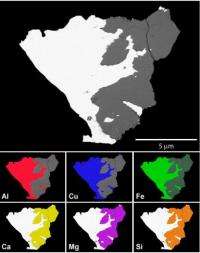January 4, 2012 report
Research team suggests rock found in Russia an extraterrestrial quasicrystal

(PhysOrg.com) -- Sometimes in science, the journey is just as interesting as the findings, and that certainly appears to be the case with a disparate group of scientists and their involvement with a simple rock found in a remote part of Russia. That simple rock, which has been identified as a quasicrystal, is, according to team who has been doing research on it, as they report in PNAS, most likely part of a meteorite that came from a time not long after the birth of our solar system.
The story begins with Dan Shechtman, a materials scientist who proposed back in 1982 that a type of material that sits somewhere between glass and crystal could be created. Initially derided for his ideas, he’s since won a Nobel Prize for them after other researchers managed to create such materials in their labs. Quasicrystals are unique in that instead of a uniform crystalline pattern that repeats itself, like regular crystals, they have a lattice that is ordered, but doesn’t repeat.
After reading Shechtman’s papers on the subject, theoretical physicist Paul Steinhardt, now with Princeton, got it into his head that such structures, which he called quasicrystals, should be able to come into existence naturally. So he began to look for them.
Fast forward eight years. Hearing about Steinhardt’s quest, Italian mineralogist Luca Bindi, contacted him about some rocks that had made their way into his collection, one of which, he thought, appeared particularly promising.
After some initial analysis, the two became convinced that the rock was indeed a naturally occurring quasicrystal, though its origins remained a mystery. Enter Glen MacPherson, a mineral scientist with the Smithsonian Institute, who was initially skeptical about both the makeup of the rock, and the theories that Steinhardt and Bindi were tossing about concerning its possible origins, i.e. that it came about naturally, likely from outer space.
After some serious study however, which included the use of mass spectrometry to measure the different isotopes of oxygen contained in parts of the rock sample, the team has become convinced that the rock, which they believe was found in a remote part of Russia, originally came from a type of meteorite known as a carbonaceous chondrite which are believed to have come about shortly after the birth of the solar system. In addition to the type of minerals found, there is also a form of silica in the rock that is only known to form under extremely hot and pressurized conditions, such as when a meteorite strikes the Earth. Thus, they conclude, quasicrystals can indeed be created naturally, though it’s still not clear what sorts of conditions might have existed in the depths of space to have resulted in the natural development of such a unique type of material.
More information: Evidence for the extraterrestrial origin of a natural quasicrystal, Published online before print January 3, 2012, doi: 10.1073/pnas.1111115109
Abstract
We present evidence that a rock sample found in the Koryak Mountains in Russia and containing icosahedrite, an icosahedral quasicrystalline phase with composition Al63Cu24Fe13, is part of a meteorite, likely formed in the early solar system about 4.5 Gya. The quasicrystal grains are intergrown with diopside, forsterite, stishovite, and additional metallic phases [khatyrkite (CuAl2), cupalite (CuAl), and β-phase (AlCuFe)]. This assemblage, in turn, is enclosed in a white rind consisting of diopside, hedenbergite, spinel (MgAl2O4), nepheline, and forsterite. Particularly notable is a grain of stishovite (from the interior), a tetragonal polymorph of silica that only occurs at ultrahigh pressures (≥10 Gpa), that contains an inclusion of quasicrystal. An extraterrestrial origin is inferred from secondary ion mass spectrometry 18O/16O and 17O/16O measurements of the pyroxene and olivine intergrown with the metal that show them to have isotopic compositions unlike any terrestrial minerals and instead overlap those of anhydrous phases in carbonaceous chondrite meteorites. The spinel from the white rind has an isotopic composition suggesting that it was part of a calcium-aluminum-rich inclusion similar to those found in CV3 chondrites. The mechanism that produced this exotic assemblage is not yet understood. The assemblage (metallic copper-aluminum alloy) is extremely reduced, and the close association of aluminum (high temperature refractory lithophile) with copper (low temperature chalcophile) is unexpected. Nevertheless, our evidence indicates that quasicrystals can form naturally under astrophysical conditions and remain stable over cosmic timescales, giving unique insights on their existence in nature and stability.
© 2011 PhysOrg.com



















